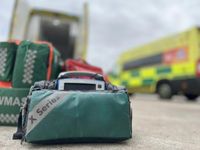A dramatic rescue unfolded in the heart of the Peak District on Wednesday, August 27, 2025, after a man suffered a perilous fall down a steep hillside near Ilam Moor Lane in the village of Ilam, Staffordshire. The incident, which occurred shortly after 10:30 in the morning, drew a rapid and coordinated response from multiple emergency services, ultimately resulting in the man being airlifted to a major trauma center for urgent medical care.
According to reports from BBC News, the man was found by the Peak District Mountain Rescue team on the side of a hill, approximately 100 meters above ground level. The area, renowned for its rugged beauty and challenging terrain, quickly became the scene of a complex and high-stakes rescue operation. The West Midlands Ambulance Service, which responded promptly to the emergency call, described the man’s injuries as potentially serious and noted that immediate trauma care was administered on the hillside.
The alarm was raised at 10:46 AM, as confirmed by a spokeswoman for the West Midlands Ambulance Service. She stated, “When ambulance crews arrived they found the man located on a steep area of hillside, approximately 100 metres from ground level, after reportedly falling down part of the slope. He had sustained potentially serious injuries and received trauma care from ambulance staff on the hillside.” This account, echoed by several regional news outlets including Birmingham Live and StokeonTrentLive, underscores the severity of the situation and the immediate need for expert intervention.
The Midlands Air Ambulance from Cosford was among the first emergency vehicles dispatched, joined by a land ambulance and a paramedic officer. The Trust’s control room also quickly requested the assistance of the Peak District Mountain Rescue team, whose expertise in navigating treacherous landscapes proved vital. The fire service was also called in to support the operation, reflecting the seriousness and complexity of the rescue effort.
Upon arrival, rescuers located the injured man on a particularly challenging section of the hillside, roughly 100 meters up from the valley floor. The steepness and instability of the terrain made conventional evacuation impossible, prompting the use of a specialized rope system to safely lower the patient to ground level. As reported by West Midlands Ambulance Service, “Once stabilised, mountain rescue and fire service colleagues safely lowered the patient to ground level using a rope system. The man was then carried to the awaiting air ambulance before being flown to Royal Stoke University Hospital for further emergency care.”
The Royal Stoke University Hospital, a major trauma center renowned for its expertise in treating severe injuries, became the next critical link in the patient’s journey. The air ambulance landed at the hospital, ensuring that the man received the advanced medical attention he urgently required. The hospital’s trauma specialists are well-versed in handling complex cases arising from outdoor accidents in the region’s popular but hazardous landscapes.
This incident highlights not only the inherent dangers of exploring the Peak District’s dramatic scenery but also the remarkable skill and dedication of the region’s emergency responders. The collaborative effort between the ambulance service, air ambulance, mountain rescue, and fire service showcases a well-oiled system designed to tackle emergencies in even the most inaccessible locations. As the spokeswoman for West Midlands Ambulance Service detailed, the process from initial stabilization to the final airlift was executed with precision and care, reflecting the high level of training and preparedness among all involved.
The Peak District, straddling several counties including Staffordshire and Derbyshire, draws thousands of visitors each year who seek adventure amid its rolling hills, limestone valleys, and picturesque villages. While the region’s beauty is undeniable, its rugged terrain can quickly turn treacherous, particularly for those unfamiliar with its hidden dangers. Steep slopes, loose rocks, and unpredictable weather conditions all contribute to a landscape that demands respect and caution from hikers and outdoor enthusiasts.
Local authorities and rescue organizations frequently remind visitors of the importance of preparation and awareness when venturing into the area. The events of August 27 serve as a sobering reminder of how quickly a day out in nature can become a life-threatening ordeal. Despite the best efforts to promote safety, accidents do happen, and when they do, the region’s emergency services are often called upon to perform rescues under challenging circumstances.
Rescue operations in the Peak District are far from rare. The Peak District Mountain Rescue team, comprised largely of highly trained volunteers, responds to numerous incidents each year ranging from minor injuries to major emergencies like the one witnessed on Wednesday. Their ability to operate in difficult terrain, often in adverse weather, is a testament to their commitment and skill. The use of rope systems, as in this case, is a standard procedure for extracting casualties from steep or inaccessible locations, ensuring both the safety of the patient and the rescuers.
The Midlands Air Ambulance Charity, which operates several helicopters across the region, plays a crucial role in providing rapid transport to specialist hospitals. Their helicopters are equipped with advanced medical equipment and staffed by experienced clinicians capable of delivering life-saving interventions en route to hospital. The speed with which the air ambulance can reach and evacuate patients from remote areas often makes the difference between life and death.
As for the man rescued on August 27, his current condition has not been disclosed, but the prompt and coordinated response undoubtedly gave him the best possible chance of recovery. The incident has prompted renewed calls for caution among those enjoying the Peak District’s natural wonders. Local rescue teams stress the importance of checking weather conditions, wearing appropriate footwear, and carrying essential supplies such as maps, compasses, and first-aid kits. Even experienced hikers can find themselves in trouble, and mobile phone signals are not always reliable in remote valleys and hillsides.
Reflecting on the day’s events, the professionalism and courage of the emergency teams stand out as a beacon of hope in a potentially tragic situation. Their ability to work together under pressure, using specialized equipment and hard-won expertise, is a vital asset to the region and a reassurance to all who venture into the wild beauty of the Peak District.
Though the rescued man’s ordeal was harrowing, the swift intervention of the Midlands Air Ambulance, the Peak District Mountain Rescue team, the fire service, and the West Midlands Ambulance Service ensured a positive outcome. Their actions serve as a powerful reminder of the value of preparedness, teamwork, and community spirit in the face of adversity.





